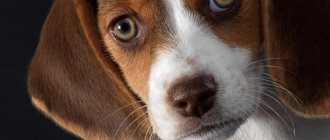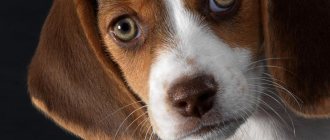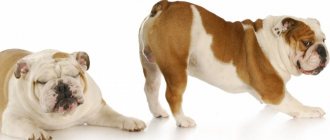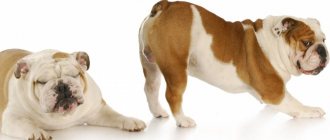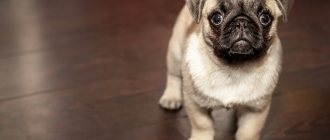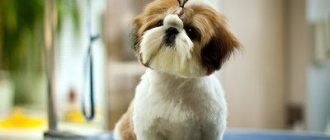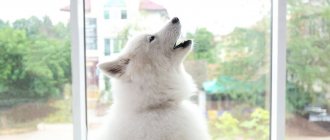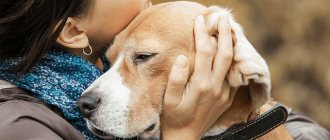- December 22, 2019
- Dogs and hunting with them
- Ekaterina Gordeeva
Once upon a time there was a man who dreamed of a dog with all his soul. Only this person was sincerely perplexed: what is the difference between dogs from elite nurseries and the most ordinary ones bought at the “bird” market or through an advertisement on the Internet? Why pay more for a puppy when you can get it cheaper?
And one day a man bought a dog from an advertisement. Together with the pet, the owner was given a small piece of paper with a seal, explaining that this was a real pedigree. But over time, it turned out that our hero was “cheated”, his dog was a cross between a “bulldog and a rhinoceros”, and his pedigree was “fake”.
Due to the fact that such situations occur quite often in everyday life, the question arises: how to check the pedigree of a dog? This is what we will talk about.
Pedigree is...
When planning to get a puppy, it is worth studying not only the characteristics of the desired breed, but also the nurseries that sell its representatives. Why nurseries with their sky-high prices? Yes, because when buying a puppy there, the owner will receive a real pedigree and will not find himself in the situation described above. It is unlikely that such an owner will have to think about how to check the dog’s pedigree in the future.
Let's start with the very concept of "pedigree". This is a document confirming the purebred of the animal. There are several types of pedigrees.
Content
- 1 I. GENERAL PROVISIONS
- 2 II. ORGANIZATION OF BREEDING WORK
- 3 III. RKF REQUIREMENTS FOR ADMISSION OF DOGS INTO PEDIGREE BREEDING
- 4 IV. FCI REQUIREMENTS FOR ADMISSION OF DOGS FOR BREEDING
- 5 V. BREEDER
- 6 VI. PROCEDURE FOR REGISTRATION OF A FACTORY ATTACHMENT
- 7 VII. BREEDING KENNEL
- 8 VIII. KNITTING. ACT OF MATING
- 9 IX. PROCEDURE FOR REGISTRATION OF MATINGS AND BIRTH OF PUPPIES
- 10 X. INSPECTION OF LITTERS AND CONTROL OF THE QUALITY OF THEIR GROWING
- 11 XI. BRANDING AND CHIPING
- 12 XII. REGISTRATION AND ISSUANCE OF DOCUMENTS OF ORIGIN
- 13 XIII. ALL-RUSSIAN UNIFIED PEDIGREE BOOK RKF (VERK)
- 14 XIV. SANCTIONS
- 15 Links
Types of pedigrees
We'll talk about how to check a dog's pedigree a little later. Now it’s worth considering the types of this document:
- An international pedigree is required to take a dog abroad. As a rule, such a document is needed for foreign exhibitions, matings and traveling with your pet.
- RKF pedigree is the most common option. RKF is the Russian Cynological Federation, in which nurseries engaged in breeding one or another breed are registered. The presence of the RKF pedigree confirms the purebred of the pet.
- Pedigree SKOR (Union of Cynological Organizations of Russia). Often, newbie dog lovers have a question: why are SKOR dogs worse than RKF dogs? The fact is that the RKF does not recognize pedigrees obtained from SKOR, therefore dogs from there are prohibited from taking part in exhibitions held under the auspices of the RKF. And SKOR dogs are much simpler in appearance than RKF dogs. To get a SCOR pedigree, it is enough to take the animal to a couple of exhibitions and get positive marks.
IX. PROCEDURE FOR REGISTRATION OF MATINGS AND BIRTH OF PUPPIES
1. Each cynological organization (club) or kennel maintains a Book of registration of matings and whelpings according to the model approved by the RKF (see appendix). In the Book of registration of matings and whelpings, the sheets must be numbered, laced and sealed with the seal of a cynological organization (club) or kennel. Entries in the Book of Registration of Matings and Whelpings are made strictly according to the date of mating.
2. The responsible person of the canine organization (club) or the owner of the kennel must, before April 1 of the current year, provide to the reception of the federation where he is registered, the original Book of registration of matings and whelpings for cancellation with a stamp of the federation indicating the date, and a copy of the sheets of the book of matings and whelpings last year.
3. The owner of the bitch - a member of the club, within 3 days, is obliged to provide the club with the original of the mating certificate completed and signed by the parties with copies of the documents for the male received from the owner of the male and the documents for the female attached by the owner of the bitch necessary for registration of this mating in the Book of Registration of Matings and Wuppings club. The person responsible for maintaining the club's Book of registration of matings and whelpings is obliged to make an entry in the Book about matings within 3 days from the date of receipt from the owner of the bitches the original Certificate of mating and copies of the documents of the dog and bitch necessary for registering the mating and litter of puppies of this breed in the club and VERK .
4. The owner of the bitch - the owner of the kennel is obliged to make an entry about the mating in the Book of registration of matings and whelpings of the kennel on the day of mating on the basis of the original Mating Certificate completed and signed by the parties and copies of the documents of the dog and the bitch, necessary for registering the mating and litter of puppies of this breed in the VERK.
5. If the mating of a bitch is carried out with a male belonging to a foreign owner, then an entry about the mating in the Book of registration of matings and whelpings of a club or kennel must be made within the deadlines established above, and under the obligatory condition that the Mating Certificate completed and signed by the owners of the male and female international standard (see appendix), confirming the fact of mating, copies of the export pedigree of a foreign male sire, owner's certificate, exhibition diplomas, certificates confirming titles, training, testing, necessary for registration of mating and litter of puppies of this breed are attached, received from the owner of the male dog. in the club/kennel and VERK.
6. If it is officially established and documented that a female is bred to 2 or more males, the litter is not registered in the RKF.
7. The owner of a male dog is recommended to keep a book of matings of his male dog.
8. In case of non-compliance with the requirements set out in Articles VIII and IX of these Regulations, the RKF has the right to suspend the registration of mating and birth of puppies or refuse to register the mating and birth of puppies.
Obtaining a pedigree
Before you think about how to check a dog's pedigree, you need to understand how to get it.
The pedigree is obtained through the breeder after the dog reaches 15 months of age. Before this, the main document is the “puppy card” - a kind of pet birth certificate. Once the animal reaches the stated age, the “puppy” changes to pedigree.
What is puppy metrics and pedigree: why these documents may be needed
The metric, or “puppy”, is one of the doggie’s very first documents.
It is issued during the litter activation period. To obtain a puppy card, you will have to call a representative of the kennel club to inspect and describe the litter. He must carefully examine each puppy and draw up an examination report. Important! You can only get this paper if the dogs have a mark.
Pedigree is an extract from the Verkhovna Rada, with the help of which you can check the full origin of the dog. This puppy card contains information about the dog’s parents. It allows you to engage in breeding dogs.
By appearance
How to check the authenticity of a dog's pedigree? If the owner holds a document of a certain type in his hands, then he can be sure that the pedigree is real. It's all about the hologram and watermarks, which are noticeable upon closer inspection of the pedigree, as well as in the profile image of the greyhound.
Let's talk a little about deciphering the RKF pedigree. In the center are the dog's details: name, breed, date of birth, brand, color, breeder and owner. The document must contain information about the pedigree and its serial number in the RKF.
Under the numbers “1” and “2” are the dog’s father and mother, followed by grandparents, great-grandparents.
XIV. SANCTIONS
1. For untimely submission of documents to the RKF for registration of litters, the right of a territorial cynological organization or nursery to conduct breeding work may be temporarily suspended.
2. For violations of the RKF Regulations on breeding work, the following sanctions may be imposed:
- warning;
- reprimand;
— registration of a litter with a temporary ban on the mother’s use of puppies in breeding;
— refusal to register the litter;
— temporary ban on breeding work;
— an indefinite ban on breeding work.
3. For the use of infected breeding stock, which leads to the spread of infectious diseases, sanctions may be imposed on their owners, including a ban on breeding work.
4. The RKF Breeding Commission considers received allegations of violations of this Regulation in the presence of interested parties, or in the presence of written explanations from both sides. If explanations are not provided, the RKF Breeding Commission has the right to make a decision without them.
5. Violations of the rules for conducting breeding work by cynological organizations, kennel owners, breeders and owners of male dogs include:
— unsatisfactory maintenance of breeding animals and unsatisfactory rearing of young animals;
- deliberate spread of hereditary diseases and defects in the breed, concealment of them;
— falsification of information in breeding documentation.
According to the application to the RKF
Is it possible to check the pedigree of a dog (RKF) using the brand number? We will talk about this below. Now let’s talk about such a moment as an application to the specified organization.
Attention! An application can be written only if the pet has the RKF mark, otherwise the owner will be denied consideration of his application.
The application can be submitted electronically on the official website of the RKF, but it is better to go to the organization and write it in person. Of course, this option is only suitable for residents of Moscow and the surrounding Moscow region. RKF is located at:
Moscow, st. Gostinichnaya, 9.
Separation by wool type
The type of coat affects the difficulty of grooming. Long-haired pets with fluffy and curly hair require regular grooming, which not every owner can afford.
Naked
Contrary to popular belief, hairless breeds are not always hypoallergenic, as saliva and other secretions cause the reaction. And such pets are very vulnerable to sunlight and frost.
Due to the lack of hair, sebum quickly accumulates on their body, causing an unpleasant odor if regular washing is neglected. If you are not afraid of difficulties, then pay attention to the American Hairless Terrier, Chinese Crested, Peruvian Hairless, Mexican or Ecuadorian Hairless dog.
Smooth-haired
Dachshunds, bulldogs, Dobermans, Great Danes and Dalmatians are similar in that they have short guard hairs and no undercoat. They practically do not shed, and their coat does not require complex care.
Shorthair
This includes English Bulldogs, Beagles, Jack Russell Terriers, Labrador Retrievers and Pugs. They are distinguished from the previous group by a less smooth, but thicker coat and a small undercoat. Thanks to good hairs, all these pets are not as susceptible to external influences as hairless and smooth-haired ones.
Longhair
Yorkshire Terriers, Maltese, Collies, Chow Chows and Shih Tzus look very impressive, but require very frequent grooming. Otherwise, their fur quickly becomes tangled, and this provokes dermatitis and other skin diseases.
Wirehaired
The coat of Airedale Terriers, Brussels Griffons, Hungarian Vizslas, Deerhounds and Drahthaars needs to be plucked periodically, as they hardly shed. Despite some difficulties, such pets will definitely not litter the apartment with their fallen hairs.
By brand
How to check a dog's pedigree by brand? It's not that easy, but it's quite possible. There are two ways:
- Directly in the RKF itself.
- Via the Internet on special sites dedicated to certain breeds.
If you need to check the pedigree of a dog using the brand number through the RKF, you can call this organization, provide the brand and ask for the pedigree number. This method exists, but rarely leads to positive results.
It is much easier and more effective to check the pedigree of a pet using the brand via the Internet. There are a great many websites - databases that contain information about representatives of a particular breed, and indicate nurseries in whose stud books these animals are registered.
VII. BREEDING KENNEL
1. The nursery can be registered by a breeder, at least 18 years of age, who has a factory prefix registered with the FCI, zootechnical or veterinary education, or the title of judge of the RKF for breeds, or a certificate of completion of courses (judges, breeding instructors, breeders, breeders, dog handlers).
2. The nursery is registered on the basis of breeding stock. To establish a kennel, its owner must own at least one breeding bitch.
3. The owner of the nursery works with the RKF through member organizations of the RKF.
4.The writing of the name and address of the nursery is submitted to the RKF only in Russian. Transliteration of the name and address of the nursery is carried out by an employee of SOKO RKF.
If you find a dog on the street
So we found out how to check the pedigree of a dog by the number (RKF) of the mark. One of the easiest ways is a database provided on the Internet. Therefore, if you find a purebred (at first glance) dog on the street, first of all you need to examine it for the presence of a brand. For large dogs, it is usually placed in the ear or on the stomach. For small breeds - only on the stomach.
IV. FCI REQUIREMENTS FOR ADMISSION OF DOGS FOR BREEDING
1. Dogs that have a certificate of origin from the RKF, FCI, AKC, KC, CKC are allowed for breeding.
2. Dogs that have a conformation rating of at least “very good”, obtained at an official certified exhibition of the RKF (the exhibition published in the RKF exhibition calendar is considered official) or the FCI International Exhibition, are allowed for breeding use. Owners of breeding dogs must submit the original diploma once. In exceptional cases (injury), a description of the breed judge on a special form is required with a conclusion that the dog meets the breed standard and a rating of at least “very good”. The judge is obliged to make sure that the dog has a mark (and, if available, a microchip). (see Attachment). Puppies born from such sires are registered with the VERK from the island.
What is a brand?
Usually the brand is the first three letters of the name of the kennel, followed by the serial number of the dog. This serial number is entered into the pedigree, and the pet receives it at birth from the breeder. The breeder registers the newborn puppy in the nursery's stud book, recording its serial number. For example, if the puppy is the 200th born in this kennel, then its number will be “200”.
An example of a nursery brand: LIN 123. We have found out what the numbers and letters mean.
How to find a dog's owner?
Dog brand
is a set of letters (identification marks of the kennel/club) and numbers (the serial number assigned to the puppy). The kennel (or a private breeder through a club) brands and registers the litter with the Kynological Federation (in Russia this is the RKF). The metrics of branded puppies have only the breeder's data.
Interesting materials:
How long can an iPhone stay in water? How many iPhones will be released in 2020? How many amps is the iPhone XS Max? How many amps is the battery for iPhone 6s? How many amps is the battery on iPhone 6s? How many amps to charge an iPhone? How many amps does iPhone XR have? How many amps does it take to charge an iPhone 10? How many amps does it take to charge iPhone 8 Plus? How many amps does iPhone 12 have?
We are looking for owners
You are lucky, the dog has a mark, and we managed to find out which kennel your find came from. The next step is simpler: we find the website of this nursery and the phone number of the breeder, call him and find out who the owners of the animal are.
If you advertise online that you have found a dog, be careful. “Owners” will come running for free, many want to take a purebred pet “for free,” but you are not a mistake either. Ask potential owners to check the dog's name and brand number.
Does a dog need documents?
The very first documents that a purebred puppy “acquires” are an inspection report and a puppy card (“puppy” as the document is colloquially called). Activation of puppies is carried out in the first weeks after birth (no later than 2 months of age). Puppies are given nicknames, and a description is written on a standard form. It should indicate the color of the puppy, signs of compliance with the breed and deviations from it - if any, information about physical development and behavioral characteristics. What experts evaluate:
- the presence or absence of congenital anomalies, disqualifying defects;
- compliance with breed standards;
- quality of rearing: the dog handler ensures that the puppies are sufficiently well-fed, but not overfed, and that there are no signs of infection with intestinal and ectoparasites.
The act is drawn up by specialists from the kennel club of which the breeder is a member. Then a litter inspection protocol is drawn up - based on the inspection of all puppies in the litter, registration is made in the Puppies Book. Why is this necessary? Firstly, to assess the integrity of breeding work, and secondly, the data can be used to identify lost and found animals.
A little about SKOR pets
Do you need to check the pedigree of a dog registered with SKOR? In fact, there are much more problems with such animals than with those registered in the RKF. Why? Yes, because SKOR has simplified requirements for obtaining pedigrees for its dogs, unlike the Russian Cynological Federation.
But this is a small digression. In order to check information about the dog's pedigree number in SCOR, you must follow the verification algorithm in RKF. The ideal option would be to search for the mark in the appropriate database, contact the breeder and subsequently the owner of the animal. But this is the case when we are talking about a found dog.
V. BREEDER
1. The breeder is considered to be the person in whose possession (rent, co-ownership) the bitch is located in the period from the moment of mating to the moment of final registration of the litter.
2. In case of purchasing a mated bitch, ownership is registered at the time of purchase with all necessary documents attached and the rights of the breeder are transferred.
3. The rental of a dog for breeding use is formalized by a written Lease Agreement between the lessor and the lessee, indicating all special conditions. (see Attachment)
4. The lease agreement is an integral part of the set of documents required for registering the litter.
5. Co-ownership is formalized in the same way as a lease.
6. The breeder has the right to register his factory prefix with the RKF - FCI and in this case becomes protected from the use of this prefix by other breeders.
7. The nicknames of all puppies born to a breeder with a registered prefix contain the name of this factory prefix.
Problems when checking pedigree
Alas, representatives of the RKF and other cynological organizations often refuse to provide information about the dog’s pedigree. This is not surprising, since the pedigree is the main document, which, if translated into human language, is the animal’s passport. Who will provide passport data to a stranger? The same is true with the pedigree; it is easier to check the data on an animal by brand than to check the dog’s pedigree using the RKF number. After all, each such document has a specific number assigned to the animal in a given organization. If, of course, the nursery where the dog was born is registered with the RKF.
I. GENERAL PROVISIONS
1. These Regulations are drawn up in accordance with the FCI Regulations on breeding work and in compliance with the principles of humane treatment of animals.
2. The regulations on breeding work are mandatory for all organizations of the RKF system, breeders and owners of stud dogs. The RKF system is a form of SOKO RKF organization, which includes the RKF itself, the Federations - members of the RKF, organizations - members of the Federations, breeders and owners of nursery names.
3. Breeding work is carried out with purebred dogs registered in the All-Russian Unified Pedigree Book of the RKF (hereinafter referred to as VERK), other FCI member organizations, as well as in the pedigree books of AKC (American Kennel Club), KC (English Kennel Club), CKC (Canadian Kennel Club).
4. The regulations on breeding work promote the breeding of functionally healthy dogs with adequate behavior.
5. The appendices are an integral part of this Regulation.
If there's nothing
What to do when you find a dog on the street, but there is no mark or chip? Moreover, it is clear that the animal is purebred, as evidenced by its exterior, but it is impossible to check the presence of a pedigree and find out which kennel the dog is from. In this case, it will not be possible to check the pedigree; you will have to look for the owners in other ways.
One option is to post about the found dog on social networks, taking several photos of the animal. It is advisable to post this post in local city public pages (groups), as well as on free city bulletin boards. You just have to be vigilant, because you never know who will want to introduce themselves as the owner.
In correspondence or telephone conversation with the owner, be sure to ask for the animal’s name, age, and special features. The owner wants to come pick up the dog? Very cool, just let him take his passports with him, both his own and the veterinarian’s. Isn't there any of this? To no, as they say, there is no trial.
What if the owner threatens to write a statement to the police, considering the person who found the dog guilty of stealing it? If there are no documents confirming that the animal is the property of this person, the latter will not be able to do anything. Be that as it may, a dog is property, and property requires certain documents. In our case, a pedigree indicating the initials of the owner.
Registration process
The procedure for issuing a card consists of several stages:
- Submitting an application for registration. To submit an application, you will have to first fill out a paper confirming that the mating was carried out after the permission of the club.
- Obtaining a certificate of inspection of dogs before mating. We must also ensure that the dogs have all their vaccinations.
- Carrying out examination of newborn puppies. Only non-rejected dogs can receive the card.
Important! If the above conditions are met, the club will issue a puppy registration without any problems.
If your dog is missing
Be prepared for the fact that those who find them will ask for a certain reward for the capture and maintenance of the animal. Of course, you can be indignant, and even contact the police, but anything can happen in life, and there are no guarantees that the dog will not disappear again. And then, if the animal is found by the same people, everything can turn out very badly.
So prepare a reward, the animal’s pedigree, your passport and name the distinctive features of the dog, its name and age.
Where to make a certificate: SKOR or RKF (RKF)
Example of a puppy's pedigree
Most often, people register puppies at the RKF. The main distinguishing feature of this organization is that it carefully monitors the quality of puppies. RKF representatives also monitor the mating procedure.
If you need to get your metrics done quickly, you can contact SKOR. With the help of the canine union, a puppy card is issued many times faster. If the authenticity of the card is confirmed, the dog will be able to participate in exhibitions in the CIS countries.
Why do you need a pedigree at all?
First of all, in order to have proof of the purebred dog and its belonging to a certain breed. Pedigree is not a panacea for all ills; there are dogs from good kennels with an excellent pedigree, but a problematic psyche. However, this document gives at least some kind of guarantee to the owner.
The second point is what is described above. Pedigree is the main canine document. If an animal is lost or stolen, it will be much easier to return the pet. Dogs registered with the RKF must have a mark, which can be used to identify the nursery where the animal was taken from, contact the owner and return the pet to him.
VIII. KNITTING. ACT OF MATING
1. The fact of mating of dogs (initial and control) is certified by the owner of the dog, the owner of the bitch and, if present, the mating instructor, and is necessarily drawn up with a mating certificate on a form approved by the RKF (see appendix) on the day of mating.
2. Immediately before the mating of dogs (initial and control), the owners of the bitch and male and, if present, the mating instructor, must identify the male and female by the marks on them for compliance with their Certificates of Origin (pedigrees), make sure that they match their pedigrees.
3. After identification, the male and female are mated.
4. Immediately after mating the dogs, the owners of the dog and the bitch and, if present, the mating instructor, draw up and sign a mating certificate on a form approved by the RKF in 3 copies (one for the dog owners and one for registration of the mating in the Mating Registration Book and whelping of the club/kennel and subsequent transfer for registration of the litter in the RKF). The owners of the dog and the bitch, and, if present, the instructor must clearly fill out all the columns of the mating certificate.
5. The owner of the male dog, immediately after filling out and signing the mating certificate in 3 copies, is obliged to provide the owner of the mated bitch with copies of the male’s documents (pedigree, exhibition diplomas, certificates confirming titles, training, testing) necessary for registering the mating and litter of puppies of this breed in the club / nursery and RKF.
6. Dog owners are required to have their signatures on the mating act certified by a notary or in the kennel club of the RKF system, or to attach to the mating act copies of passport pages containing data on the owner’s last name, first name, patronymic and place of registration, on which they put o.
7. The conditions of mating for settlements and financial obligations between the owner of the male dog and the owner of the bitch are determined in a separate agreement according to the rules established by the Civil Code of the Russian Federation.
8. Financial disagreements between the owners of a dog and a bitch are not within the competence of the RKF and can only be resolved in court.
What document is required to participate in international exhibitions?
In order for your pet to be able to take part in an international exhibition, you must first find the first competition. As soon as the owner finds it, you can start processing the documents.
What you will need:
- microchipping a dog;
- make a metric;
- for adult pets - complete a pedigree;
- certificate according to sample No. 1;
- veterinary passport.
It would be advisable to make copies of documents, which you can also take with you to the exhibition
International veterinary passport
A veterinary passport is a small brochure of international standard, which records the vaccinations and necessary procedures throughout the pet’s life in order to protect against parasites. On the first page you can find key information about the puppy.
Additional Information! A special chip is also attached to the first page. The pet's number is stored on it.
What is recorded in the veterinary passport:
- what vaccinations and vaccinations were administered to the pet’s body;
- what treatment measures were taken, whether the absence of dysplasia was checked;
- if the animal was microchipped, what is the chip number;
- whether the pet has a mark, which is very important for traveling abroad.
They begin processing the passport from the moment the dog was first vaccinated. All details related to appearance and origin are included in the document. These are mostly depicted as stickers.
The main thing you need to know is that any clinic has the right to issue this passport. It in no way confirms the purebred of the pet. The key purpose of creating a passport is to document the fact that the pet is not dangerous to others and that it itself is not in danger of illness or danger. If the owner does not obtain this passport in a timely manner, he will not have the opportunity to travel abroad.
Login to your account for legal entities
Both kennel clubs and kennels can create a personal account on the RKF.Online website. To do this, they need to open the registration page on the website - https://rkf.online/auth/registration - and in the tabs at the top of the registration form, select the one that matches their status. Next, you will need to fill out the proposed fields and send the data for verification.
By the way! You can find out how to register a club on the canine platform from the instructions posted at https://help.rkf.online/ru/knowledge.
The authorization algorithm for representatives of legal entities on the platform is no different from the login algorithm for individuals:
- open the account login page;
- enter the email address assigned to your personal account and the password for your personal account in the fields provided;
- Click on the “Login” button.
If you wish, you can check the “Remember me” box so that the next time you visit the site, your login information will be automatically entered into the form.
Certificate of kerung results
To obtain this document, the dog must undergo a special selection based on identifying working qualities, breeding merits, behavioral factors, and anatomical features of the breed.
This form is usually issued for breeding dogs of German Shepherds and Rottweilers after they have passed breeding selection. All events are carried out by specialists from the canine federation or Russian canine organizations according to a schedule approved by them. Dogs over 18 months of age are eligible for selection.
Draft about passing the breeding selection (Kerung) of the German Shepherd (Rkf.org.ru)
Draft document on passing the breeding selection (kerung) of the German Shepherd – page 2 (Rkf.org.ru)
Login to your personal account
To log into a previously created account on the RKF.Online site, the following steps will be required:
- open the main page of the official website of the federation - https://rkf.online;
- click on the “Login” link on the right side of the page header;
- In the form that appears, enter the email address associated with your account and the password set when creating it;
- Click on the “Login” button located under the fields for entering your credentials.
Advice! If you click on the eye image in the password line, all the characters entered into it will be displayed on the screen. This will make it possible to check that the code combination has been entered correctly.
Direct link to the authorization page in your personal account - https://rkf.online/auth/login. Those who plan to frequently work with the RKF.Online portal should save it in the bookmarks of their browser, or in its express panel.
